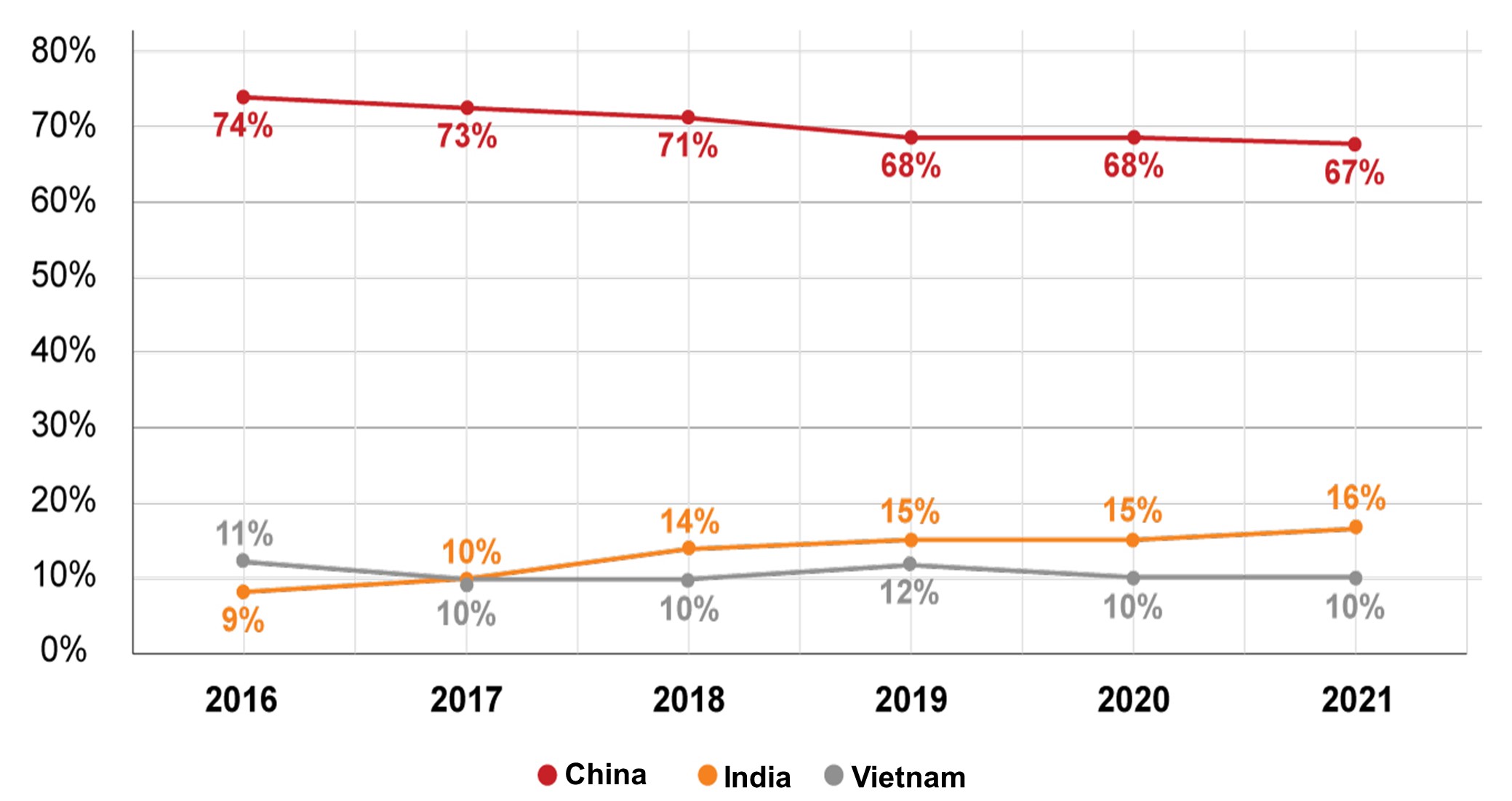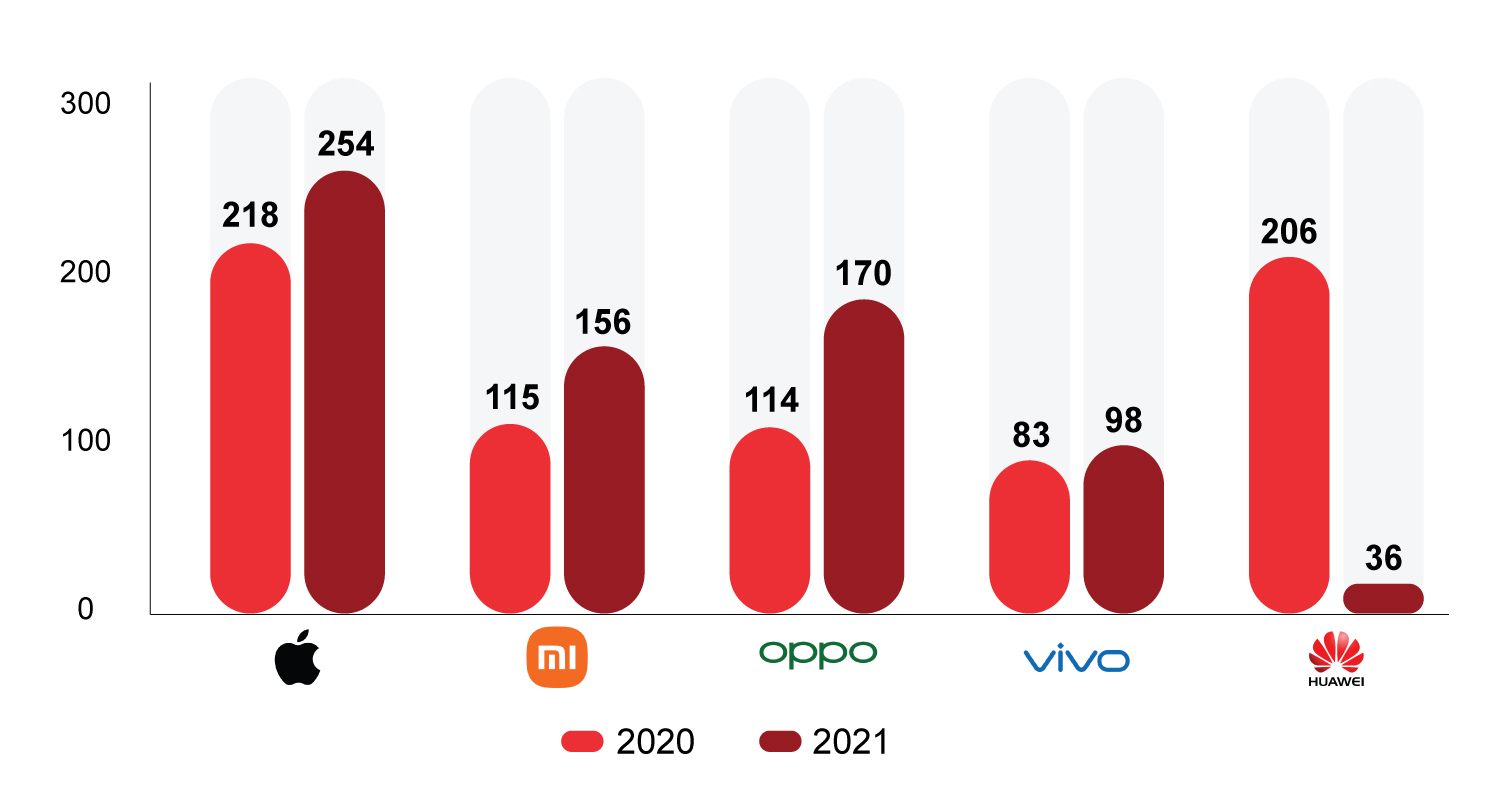The global handset production in 2021 was similar to that a year ago. Although there was a brief rise in production in some regions due to the release of pent-up demand, the negative impact of the COVID-19 pandemic remained throughout the year and did not allow recovery to pre-pandemic levels.
China remained volume leader but future position uncertain
China contributed to 67% of the global handset production in 2021, primarily because Apple and other Chinese OEMs failed to make up for Huawei’s decline in production. In 2020, Huawei accounted for the big portion of the China’s total production. Unlike Huawei, which mostly manufactures its handsets domestically, other Chinese OEMs are seeking to diversify their production sites to fulfil local demand through local production. Apple, which has a high proportion of production in China, is also looking to diversify its production sites. With diminishing demand for handsets in China, the proportion of Chinese production is also expected to decline in the future.
India a distant second with mixed signal for future growth
India accounted for 16% of global handset production in 2021. Production in India, the second largest geography in terms of production volume, rose more than 5% YoY driven by Apple, Xiaomi and OPPO. Taking into consideration Apple’s plan to produce the iPhone 14 in India, the country’s contribution will continue to rise. However, the Indian government’s regulations on low-priced phones made by Chinese OEMs might slow down this trend.
Vietnam third with 10% share, may bag iPhone production
Vietnam accounted for 10% of total global handset production in 2021, similar to that a year ago. Despite Samsung’s increased production in Vietnam, the withdrawal of LG’s smartphone business from the country had a negative effect on production volume, resulting in only a slight increase in production compared to the previous year. As Apple is moving some of its iPad production to Vietnam, the company might transfer some of its iPhone production too, which will then boost overall handset production volume in the country.
Global Handset Production Share by Country

Source: Counterpoint Global Handset Production Report
Apple actively testing locations outside China
Apple is highly dependent on China because a major chunk of its production comes from the country. However, Apple is starting to test its production sites outside China to diversify production and reduce its reliance on the country against the backdrop of the frequent domestic disruptions related to the pandemic and rising US-China tensions. The production of the iPhone 14 in India and iPad in Vietnam seems to be a part of this endeavor. However, it will take a considerable amount of time for any other country to replace the Chinese manufacturing ecosystem.
Samsung strong on diversification
Samsung can now be considered relatively well-diversified in terms of handset manufacturing. Learning from the hardships it faced during the pandemic because of its higher focus on just one country for production, the company will avoid concentration of manufacturing. Additionally, due to the division of global production chains and cost pressure caused by inflation, Samsung will pursue setting up production hubs near its major markets, such as India, Indonesia and Turkey.
Major Chinese OEMs grew in China due to Huawei’s absence
Major Chinese OEMs like Xiaomi, OPPO and vivo, which had been declining or stagnating since 2016, were able to increase their production in China in 2021 because Huawei was held back by US sanctions. Meanwhile, production volume in India increased but its proportion in global production decreased. This might remain if the Indian government continues with its additional regulations on Chinese OEMs. Indonesia is the base for Chinese OEMs in the Southeast Asian market in addition to India, and the proportion of production is expected to increase as the regional market continues to grow.
Unlike the major companies mentioned above, HONOR manufactured most of its handsets in China. The company will diversify its production bases as it looks to enter markets outside China, but, just like Huawei, it will maintain China as its main production hub.
Handset Production in China by Major OEMs(M Units)

Source: Counterpoint Global Handset Production Report
Conclusion
Although the direct impact of the pandemic continues to diminish, geopolitical and macroeconomic issues, such as conflicts and inflation, are preventing the market from recovering. The global handset market is expected to decrease by 8% in 2022 from 2021. Within this broader market, the smartphone market will have a less severe decline because of the increasing transition to smartphones from feature phones. Starting 2023, the handset market is expected to maintain a low single-digit percentage growth.
Considering the market’s reduced growth rate and the continued downward pressure on ASP of handsets, OEMs have an incentive to maintain concentrated production sites to reduce costs.
Despite this incentive, the disruptions caused by the pandemic and increasing geopolitical tensions highlighted the disadvantages of having a concentrated production site, forcing companies to set up multiple production sites.
Currently, there appears to be a balance between these two factors. However, in the long run, as the production concentration outside China increases and cost competitiveness is achieved, handset production outside China will accelerate further.
